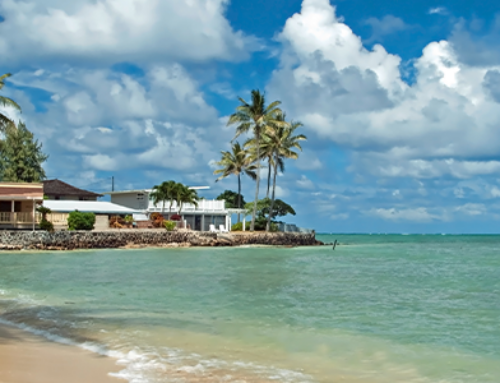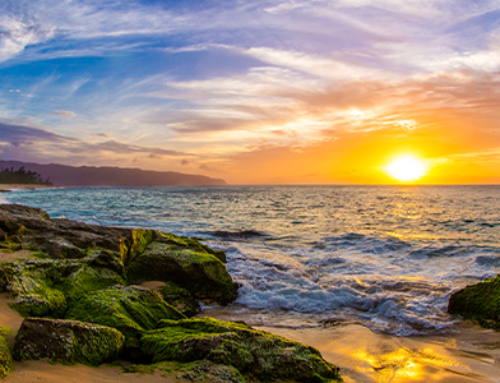When it comes to making a big move, there are a few basics you need to handle early. We’re talking about things like where you’ll live, how you’ll get around, and how you’ll get connected to the online resources you need to help make your new destination feel like home. Now, when that new home happens to be an island in the middle of the Pacific, things can feel a little more…complicated.
After all, it’s not as though you can simply pack up a moving truck, hitch your car to a trailer behind it, and drive to your new location. Add to that the fact that things work a little differently in Hawaii, and many prospective residents end up with a ton of questions about how to get even the simplest things done—like finding an apartment.
Whether you’re coming to Hawaii to work remotely, traveling to the islands to do a temporary stay and see if it’s right for you, or executing a long-term move to Hawaii, we’ll help you sort out the basics. Come along with us as we offer an insider’s guide to blazing through your Hawaii to-do list so you can get settled quickly in the Aloha State.
Let’s start with your most basic necessity: shelter.
1. What’s the Best Way to Find a House or an Apartment in Hawaii?
First, we’re going to be frank with you: It’s a lot easier to find a place to live when you’re already on island. In fact, a lot of landlords won’t even consider renting to you unless they can meet you in person.
Here’s why: A lot of people say they’re moving to Hawaii. However, as we all know, plans change and dates shift—and a lot of landlords have been left holding the bag on this one.
However, truthfully, waiting until you’re on Oahu, Maui, the Big Island, or Kauai to find long-term housing will actually work in your favor. That way, you can actually tour the place and make sure you like it. It will also help keep you from falling prey to the housing scams that pop up here every now and then. (More on that in a minute!)
Our suggestion? If you don’t have a friend you can stay with, consider getting a hotel or an Airbnb at first so you can secure more permanent housing in person.
Once you’re here, finding a place is relatively similar to finding one on the mainland. Craigslist and Facebook Groups are popular places for landlords to post listings. Additionally, rental listings have started popping up on Zillow in some neighborhoods. A lot of people also find their places through word of mouth or friends of friends, so keep your ears out once you arrive—and be friendly! Finally, if you’re here for a temporary stay (think: a month or two), you might want to check Airbnb or VRBO.
We’ve got a couple of links below to get you started. Know that we don’t endorse any of these in particular. Instead, we’re providing them to you for informational purposes to give you a head start on your research.
- Facebook Groups: You’ll often see landlords posting their properties in these groups:
- Hawaii – Housing, Apartments, Rooms, Sublets, Roommates (Statewide)
- Oahu Homes For Rent and Sale
- Honolulu Rentals, Apartments, Housing, Rooms, Sublets, Roommates
- Maui Housing – Rentals and Properties for Sale
- Maui Community Housing Board
- BIG ISLAND by Owner – Property to Sell or Rent
- Kailua Kona Long Term Rentals
- FOR RENT~ KAUAI ONLY ~ House ~ Apartment ~ Condominium ~ Studio ~ ETC……
- Craigslist – Choose your island from the strip at the top to find island-specific listings.
- AirBnB / VRBO – Better for more temporary stays.
- Zillow Hawaii Rentals – Many of these are listed through real estate agents, which offers an extra layer of legitimacy.
As you’re scanning these listings, keep your eyes and ears out to protect yourself from housing scams. We do hear about these from time to time, and usually, they’re pretty obvious if you know what to look for:
- If a property seems too good to be true (i.e., incredibly cheap for the number of bedrooms or the location), it probably is. Check out comparable listings to get a feel for what the going rate is for the type of place you want.
- If your landlord can’t meet in person—ever—this can be a red flag. (This is why it’s often better to secure a spot once you get here.) Common scams mention things like mission trips to other countries as reasons for the landlord’s absence.
- If this absentee landlord wants some kind of wire or bank transfer, it’s probably good to be wary.
- No matter what, it’s always a good idea to do your homework. If you’re renting directly from the property owner, it’s easy to search the state property records to see if the name you’re given matches. You might also consider searching the address on Google to see what comes up. If the location is an active property for sale, there might be a scam afoot.
- Finally, make sure you get a written lease agreement. Don’t let anyone tell you that written agreements “aren’t the way we do things in Hawaii.” That’s just not true. You’re always better off having something on paper that defines your relationship with anyone you live with.
Once you’ve secured a place to stay, your next job will be figuring out how to get around your new home.
2. What’s the Best Way to Find a Car in Hawaii?
If you’re coming to Hawaii to stay, you may want to ship the car you already have out here. If you’re considering that option, check out our article on the frequently asked questions for shipping your car to Hawaii. We’ll run you through exactly how it works, as well as the questions you should ask yourself to decide whether you should sell your car on the mainland or ship it to Hawaii.
If you’re coming for a shorter stay or just to check out the island, you’ll have a couple of options.
First, check out the bus system on the island where you’re planning to live. Some people in Hawaii do get by without a car, although if you want to do any adventuring, like hiking, you’ll probably want your own transportation.
- Oahu – TheBus
- Maui – Maui Bus
- Kauai – Kauai Bus
- Big Island – Hele-On Bus
If you’re not sure how long you’ll stay, you might consider a long-term rental. Depending on availability, some of the bigger agencies will offer a discounted rate for a month-long lease. You might also have some better luck with the locally-owned agencies on each island, who might be more willing to negotiate. Some, like Kihei Car Rental on Maui, have older, higher-mileage cars with a few scrapes that they’ll rent for lower prices.
If you’re in Hawaii to stay, you’ll have a few options for buying a car:
- You’ll find plenty of car dealerships across the islands that sell both new and used cars.
- You might also get a good deal by buying a used rental car from, for example, the Hertz fleet.
- You’ll also find opportunities for private sales through Facebook and Craigslist. Prices may be lower, but you’ll forego any kind of warranty that you’d get through a dealership. Of course, these come with the usual caveats, like getting a mechanic to assess any car before you buy it from an individual.
Once you’ve decided how you’re going to get around, you can turn your mind toward the next phase of your Hawaii move: getting connected for personal and professional reasons.
3. How Is Cell Phone and Internet Coverage in Hawaii?
If you haven’t spent a lot of time in Hawaii previously, you might be wondering whether the islands have fully embraced 21st century technology. (You’re probably especially concerned about this if you’re coming here to work remotely!) We think you’ll be pleasantly surprised.
All Things Internet
It might surprise you to learn that U.S News & World Reports ranked Hawaii #1 in the entire nation in Internet infrastructure. Additionally, in our experience, outages are fairly rare, maybe 1-2x a year, depending on where you live.
Our two major providers here are Spectrum and Hawaiian Telcom. As you’re looking for a place to live, we recommend looking up your potential addresses on these providers’ websites to see what kind of speeds they offer. That will give you a sense of what’s available in your area, which can vary greatly across the islands. (That said, many addresses have access to 1 gig speeds!)
Note for gamers: First, a disclaimer that we are not gamers ourselves. However, we have friends who are, and we understand that ping times matter greatly to them. Ours in Hawaii can tend to be a bit slower, so just be aware.
Curious About Cell Coverage?
For the most part, your cell phone will work in Hawaii just as well as it did on the mainland. However, like the mainland (Grand Canyon, anyone?!?), there are a few well-known dead zones across the islands. For example, entire swaths of land in Haiku on Maui have absolutely zero AT&T coverage. For the most part, these cell dead zones are public knowledge, so if you’re considering an area, all you have to do is ask, and any landlord or realtor will know the deal.
Now, if you’re considering a move while we’re still in the midst of the pandemic, a few notes for you.
4. How Is Coronavirus Affecting Hawaii?
The Hawaiian Islands have been affected by coronavirus in many ways. As a potential resident or a traveler to Hawaii, there are two big things you need to know:
#1: Statewide Mask Mandate
As of the writing of this article, Hawaii is under a statewide mask mandate, which reads:
“All individuals shall wear face coverings over their noses and mouths when in public settings.”
There are some exceptions to the rule—while eating and drinking for example—and you can get all the details on Governor David Y. Ige’s website. Either way, know that coming to Hawaii means agreeing to abide by the mask mandate, with a mahalo in advance from your new neighbors!
#2: State Quarantine Procedures
The pandemic has been a fluid situation globally, and that in Hawaii is no different. We’ve seen a lot of changes in procedures over the last few months, and the best way to get the official word is to visit the state’s COVID-19 site.
One thing we will say: Pay attention to the list of “Trusted Testing and Travel Partners.” It’s not enough to simply have a COVID test from any provider if you want to avoid a 14-day quarantine. This key detail has tripped up a number of people recently, so we wanted to make you aware.
5. What’s the Best Way to Fit in and Make Friends?
One of the things we love about Hawaii is the prevailing spirit of aloha. If you come to Hawaii with an open heart and mind—and with respect for the culture of these islands’ original inhabitants—you’ll be welcomed with aloha.
That being said, we put together a few specific dos and don’ts to help you make a smooth transition.
Don’t…
- Honk. People honk a lot less here than on the mainland. Try to keep your honks limited to dangerous situations or when you’re trying to prevent an accident.
- Wear shoes in someone’s house. Leave them outside with all the others. They’ll be there when you leave. We promise!
- Use pidgin. Unless you grew up speaking it in your household, it’s not going to come out right. Trust us on this one!
Do…
- Pull over and let locals pass you on more remote, windy roads. (They probably know every curve by heart!) Just make sure you do it in a place that’s safe for you.
- Be respectful of cultural resources. Some areas are designated only for native Hawaiians. So if you see a sign that says “kapu,” know that means to keep out. That said, whenever you get the chance…
- Immerse yourself in local culture. Go see a slack key show or a hula performance. Visit some of our museums. Read up on the history of these islands. It will only add to your overall experience in the Hawaiian islands, and give you some perspective that will make your stay more meaningful.
- Slow down and enjoy the island. Life in the Hawaiian islands tends to move at its own pace. Rather than trying to speed things along, try to slow down and enjoy the ride. We know that’s hard when you’re in line at the DMV, but the more you leave mainland speed on the mainland, the happier you’ll be in Hawaii.
- Pass on the spirit of aloha. Hawaii can be a friendly place where neighbors wave to each other and people greet you enthusiastically when you enter their stores. Keep that spirit of aloha going, and you’re sure to enjoy your time in the Hawaiian islands.
Aloha—and Welcome to Hawaii
If you’re headed for Hawaii, let us be the first to say, “E komo mai!” (Welcome!) We love it here in Hawaii, and we hope you love it, too. Things do work a little differently than on the mainland, but the tips we’ve given you should set you on the right path toward a smooth transition to island life.
And, if you decide to stay for good, let us know if you need some assistance moving your belongings to Hawaii. We’ve helped tens of thousands of individuals and families make the move, and we’d be happy to help you! We can even help you ship your car or assist with storage options if you’re still looking for a permanent place to call home. It all starts with a free quote from one of our experts. We look forward to helping you with a safe, easy, and affordable move to Hawaii.
Tell us about your move!



